Japanese New Year Customs
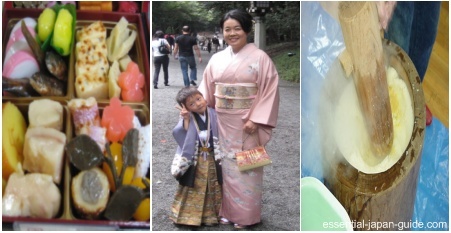
Japanese New Year (called Oshogatsu in Japanese) is Japan’s most important holiday. It is similar to Christmas in the West in that it is the time of year when families traditionally gather together to celebrate the coming new year. During Oshogatsu, most businesses close down for a few days, giving workers a few well-deserved days off. There are a number of unique and interesting customs associated with New Year in Japan.
![]()
Traditional Japanese New Year’s Greetings
Ritual New Year’s Greetings
“Akemashite Omedeto Gozaimasu.” This is the ritual greeting that Japanese mutually exchange when meeting acquintances for the first time in the new year, and is definitely a useful expression to have in your repretoire of Japanese.
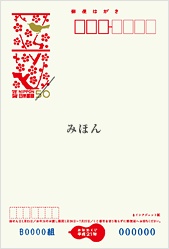
Nengajo
Nengajo are New Year’s greeting postcards that people in Japan ritually send out to friends, relatives, and business associates. These postcards traditionally arrive right on New Year’s day, and well-connected individuals and families may send and receive literally hundreds of nengajo.
![]()
Traditional Japanese New Year Customs
Osoji Year-end Housecleaning
Although not an official holiday, the Japanese New Year kicks off on New Year’s Eve. One of the most important Japanese customs on New Year’s Eve is a major housecleaning, called osoji, during which every inch of the house is scrubbed clean. The purpose of osoji is to cleanse one’s environment physically and spiritually in order to begin the new year with a clean slate. Thus it is an important holiday custom in Japan.
New Year’s Eve Temple and Shrine Visits
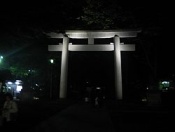
Many Japanese also pay an evening visit to Shinto shrines and Buddhist temples on New Year’s Eve. There is a ritual performed at Buddhist temples on New Year’s Eve, called Joya no Kane, during which bells are rung 108 times to purify attendees of the 108 delusions that inhabit human beings according to Buddhist belief. Meiji Jingu in Tokyo is a one of the most popular destinations for a New Year’s Eve shrine visit, attracting many thousands of visitors each year.
New Year’s Day Temple Visits – Hatsumode
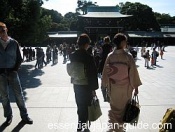
Another Japanese New Year custom is Hatsumode, the ritual first shrine or temple visit of the new year. Hatsumode usually takes place either on New Year’s Day or a few days after. Many Japanese dress up in traditional Japanese kimono during this visit. During their shrine visit, visitors pray for good fortune in the coming year and sometimes also purchase good luck charms, called omamori.
Japanese New Year Customs – Otoshidama
In Japan children receive gifts of money from their parents and relatives called otoshidama.These gifts are presented in colorful little envelopes and Japanese children look forward to receiving otoshidama as much as children in the West look forward to presents from Santa on Christmas Day.
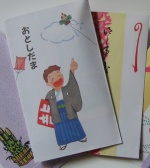
Japanese New Year’s Eve TV Programming
Kohaku Uta Gassen (Red and White Song Battle) is a music and variety show broadcast on Japan’s NHK network each year on New Year’s Eve and watched by a large percentage of the Japanese population. Kohaku features two teams (Red and White) comprised of Japan’s most popular performers across all musical genres, including J-Pop and enka. This show is also known for the performers’ elaborate costumes and stage settings.
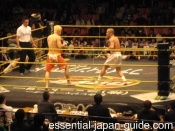
MMA on New Year’s Eve. In recent years, the viewership of Kohaku has been challenged thanks to the surging popularity of Mixed Martial Arts in Japan. Japan’s top mixed martial arts organizations Pride (now defunct) and K-1 have capitalized on this popularity by putting on big New Year’s Eve MMA events featuring the world’s top fighters. These events are televised on network TV and attract high viewer ratings.
![]()
Traditional Japanese New Year’s Food
Toshi-Koshi Soba
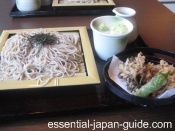
There are several types of food that are ritually eaten during the New Year’s holiday. The traditional Japanese New Year’s Eve dish is called toshi-koshi soba. Soba is buckwheat noodles, and “toshi-koshi” means to cross from the old year into the new.
Mochi and Zoni
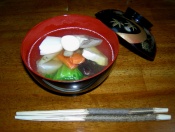
The making and eating of mochi is another traditional New Year’s custom in Japan. Mochi is made by repeatedly pounding sticky white rice until it turns into a taffy-like consistency, and then it is formed into square or round cakes. Mochi is most often either eaten grilled, or as an ingredient in a traditional New Year’s soup called zoni.
Osechi-ryori
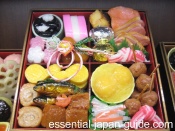
Osechi-ryori is another traditional New Year’s dish in Japan. Osechi is easily recognizable by its colorful and elaborate arrangement of fish, beans, and other ingredients, and the fancy boxes in which they are contained.
![]()
